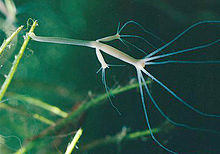Hydra oligactis
This article needs additional citations for verification. (December 2011) |
| Hydra oligactis | |
|---|---|

| |
| Scientific classification | |
| Domain: | Eukaryota |
| Kingdom: | Animalia |
| Phylum: | Cnidaria |
| Class: | Hydrozoa |
| Order: | Anthoathecata |
| Family: | Hydridae |
| Genus: | Hydra |
| Species: | H. oligactis
|
| Binomial name | |
| Hydra oligactis | |
| Synonyms | |
Hydra oligactis, also known as the brown hydra, is a species of hydra found widely dispersed in the northern temperate zone. It is a common organism found in still waters from early Spring to late Autumn.
It is commonly found attached to the stems of water plants, the undersides of leaves, submerged twigs and on the surface of stones. When disturbed it retracts to a small brown blob which is easily overlooked. Gently sweeping through a clean weedy pond and allowing the collected water and leaves to stand in a jar will often reveal Hydra emerging after only a few minutes.
When in feeding mode, the fully extended tentacles are very long and may exceed 1 inch (25 mm) in length. In this condition the tentacles are very difficult to see with the naked eye and are often only revealed when a prey animal such as Daphnia is caught. The relative length of the tentacles compared to the body is characteristic of the species and serves to differentiate it from any other brown Hydra of cool temperate waters.
When a cold sensitive strain of H. oligactis is subjected to temperature stress, it undergoes a shift from asexual budding to sexual reproduction.[2] This shift involves an upregulation of genes involved in gametogenesis, cellular senescence, apoptosis and DNA repair, and a downregulation of genes involved in stem cell maintenance.
Hydra oligactis is preyed upon by the flatworm Microstomum lineare, which incorporates Hydra stenoteles into its own epidermis.[3][4]
References[edit]
- ^ a b c d e f g Schuchert, P. (2015). Schuchert P (ed.). "Hydra oligactis Pallas, 1766". World Hydrozoa database. World Register of Marine Species. Retrieved 2015-06-29.
- ^ Sun S, White RR, Fischer KE, Zhang Z, Austad SN, Vijg J. Inducible aging in Hydra oligactis implicates sexual reproduction, loss of stem cells, and genome maintenance as major pathways. Geroscience. 2020 Aug;42(4):1119-1132. doi: 10.1007/s11357-020-00214-z. Epub 2020 Jun 23. PMID 32578072; PMCID: PMC7394996
- ^ Krohne, Georg (2018). "Organelle survival in a foreign organism: Hydra nematocysts in the flatworm Microstomum lineare". European Journal of Cell Biology. 97 (4): 289–299. doi:10.1016/j.ejcb.2018.04.002. ISSN 1618-1298. PMID 29661512.
- ^ Krohne, Georg (2020). "Hydra nematocysts in the flatworm Microstomum lineare: in search for alterations preceding their disappearance from the new host". Cell and Tissue Research. 379 (1): 63–71. doi:10.1007/s00441-019-03149-w. ISSN 1432-0878. PMID 31848750. S2CID 209380951.

